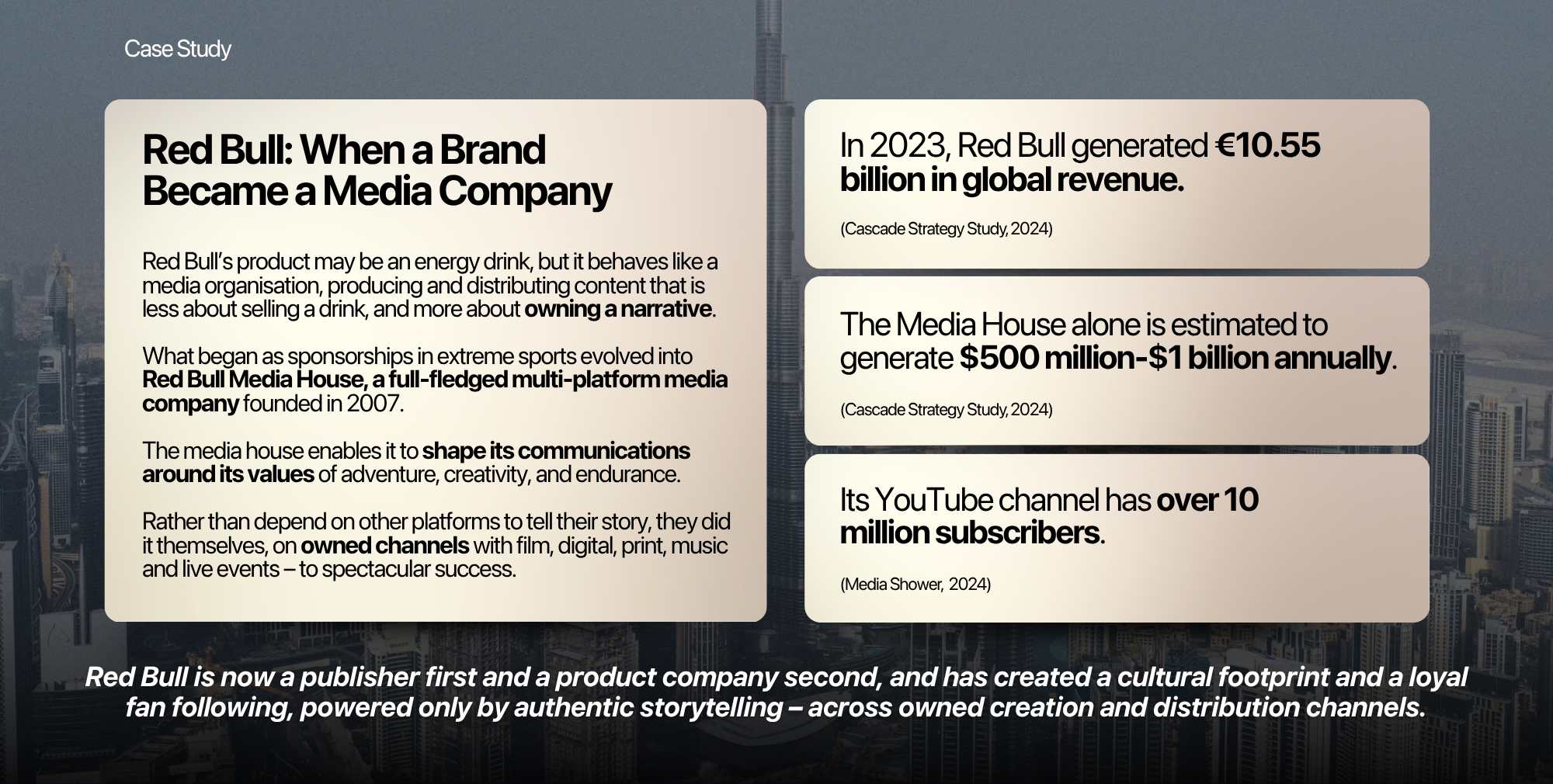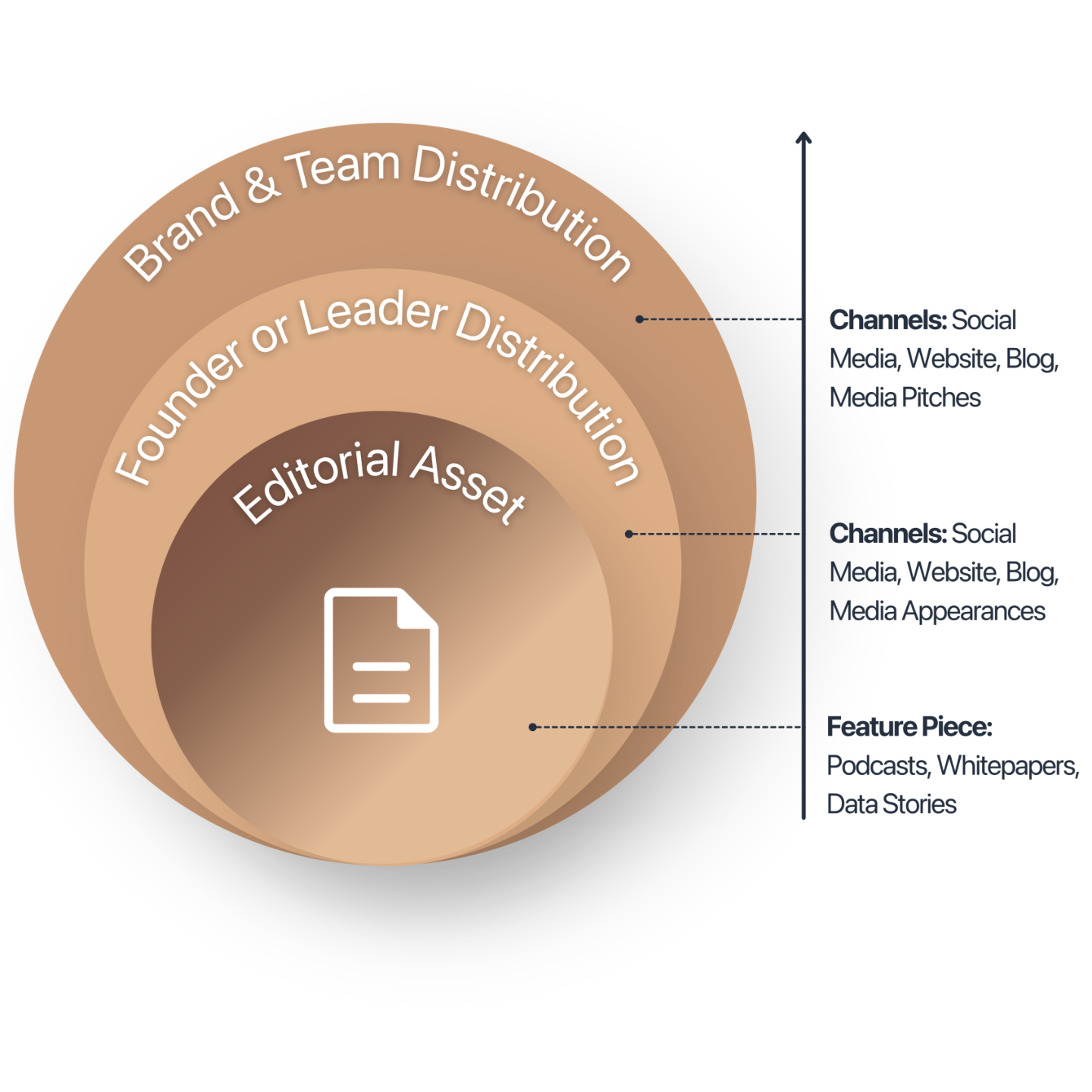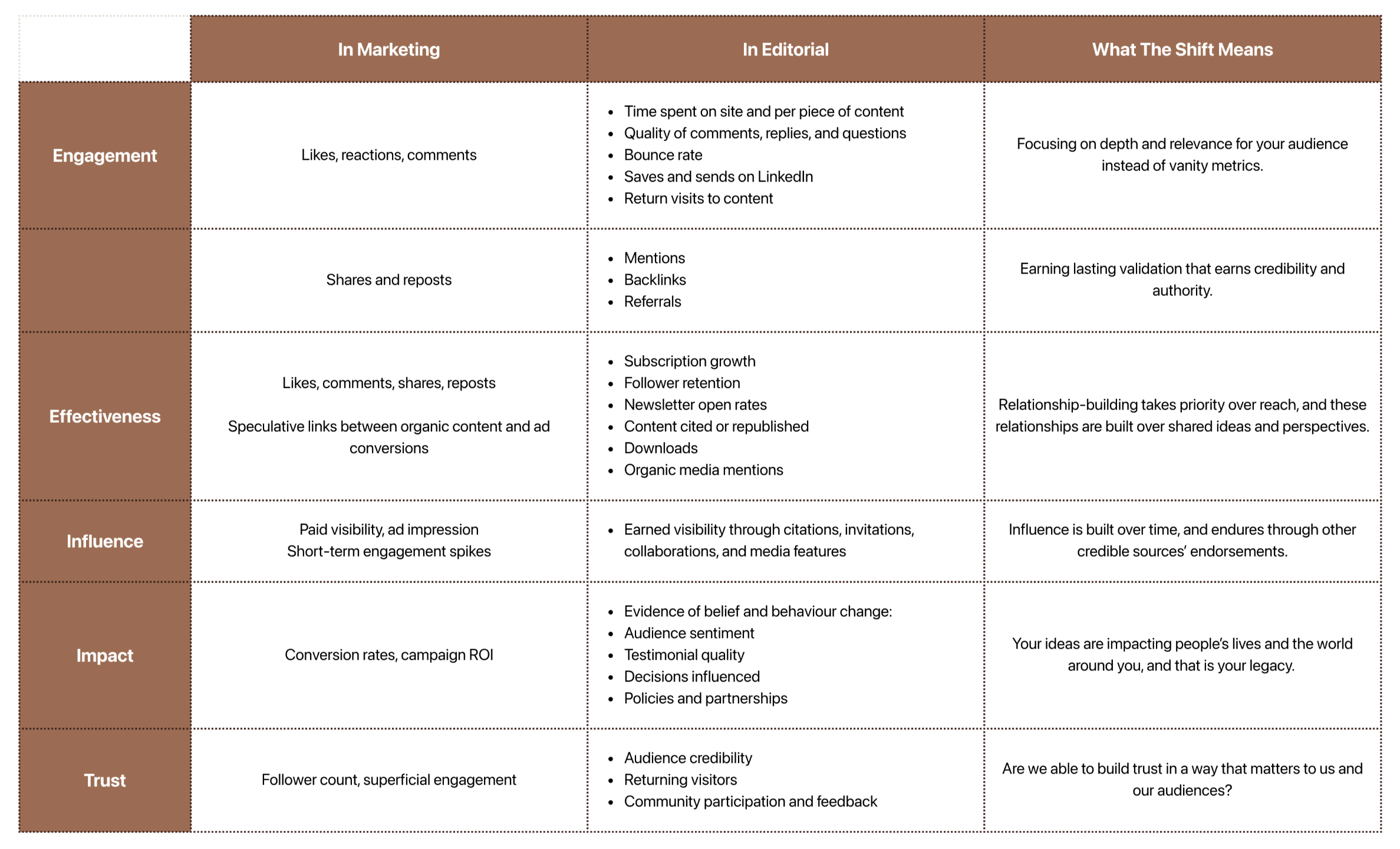A Media Model to Lead in the Trust Economy
An editorial mindset combined with a new media model is the future of leadership – a future where influence and impact are built through trust, community and autonomous ownership over your ideas and content.
Inside:
- From attention to trust
- Becoming a content company – a win for autonomy
- The rise of the editorial brand
- The editorial brand in practice
- Why this matters
- The editorial impact on commercial outcomes
- Rethinking the metrics that define communications
- A new model for leadership and influence
Since the time we’ve been able to measure ‘engagement,’ success in marketing and communications has revolved around that metric.
It became every marketer’s priority to earn attention, and we dedicated a significant amount of time and effort towards learning the tricks that would make social media algorithms work in our favour.
This focus on attention-centred metrics like reach and likes, along with the resulting commodification of big data, built the attention economy – where virality became an end, instead of a means to an end.

Though this seemed harmless at the time, it led to a major shift in power and content culture.
Brands and leaders did not have the power to control their narratives. If we wanted to take back that power and tell a story on our terms, we had to make compromises on our reach.
We felt this keenly in the world of personal branding, where it became almost imperative to sacrifice your individual voice and perspective if you wanted to be seen or heard. We could be authentic insofar as it was algorithmically correct.
As a result of the attention economy:
- Consumers ended up being served overwhelming amounts of content, because algorithms reward volume
- What we were saying became less important than how we were saying it. Content became performative
It worked.
Until it didn’t.
Information overload has made us more protective of our attention and time. As economist and psychologist Herbert A. Simon put it, “a wealth of information creates a poverty of attention.”1
We now have numbers that back Simon’s insight. 4 in 10 people now avoid the news at least sometimes, and one of the top reasons they do is because they are ‘worn out by the amount of news’, according to Reuters2. An estimated 912 million internet users also deploy ad-blockers3, further evidence that people are proactively guarding their attention.
Being performative had also given us the illusion that we had control over the audiences and influence we built through these platforms. But that illusion crumbled when almost overnight, our reach on LinkedIn fell, Twitter was taken over and its community and moderation policies changed, and Substack changed its revenue policies, significantly impacting creator revenues.
As a result, the attention economy is giving way to a trust economy, where the primary goal is no longer only to capture attention, but earn and sustain it through credibility and alignment.
PwC found that while 90% of executives believe their customers trust them, only 30% of consumers agree, showing that trust is now scarce, and therefore valuable. And this value is seen in economic terms, because 93% of business leaders say that ‘building and maintaining trust improves the bottom line’.4
In this trust economy, attention still matters. However, it cannot be bought, it needs to be earned. And it becomes valuable only when it is sustained. To sustain your audiences’ attention, you have to reward it with value. The value you offer becomes the reputation you build, and your reputation becomes the reason people trust you.

Can you do this consistently on social media alone, and should you? What works for you and your audiences often doesn’t work for an algorithm. Plus, we’ve seen that the credibility and authority you do build on these popular platforms are often dependent on them, and therefore vulnerable.
With more thought leaders and brands realising this, we are seeing the content and communications industry evolve to a new model, which draws on both the independence of pre-social media journalism, and the connectivity of the digital age.
This is giving rise to a new, better way to grow their influence – a combination of owned media to combat the volatility of external algorithms, and an editorial approach, to take back control of how they build their narratives, and for whom.
Becoming a content company – a win for autonomy
Sustainable survival and growth needs sovereignty and autonomy. We must own the place where our ideas live, and these are different to the places where they are distributed.
This philosophy is what is leading the editorial shift in content creation and communications, and the reason some of the biggest organisations in the world are now building newsrooms to become media companies in their own right.
Thinking of yourself as a media company or content company is a strategic shift. It turns your core driving philosophy into an engine that drives your reputation, work and everything else within your ecosystem, whether that’s new ventures, business pivots, or your public narratives.
All of this lives on media you own.
This evolution brings together the best of editorial strategy and digital capability.
Importantly, it is also an act of reclaiming power and control. It’s how we can be sure that when people discover us, on whichever platform, they see and hear our version of our story, in our voice, narrated in our context.
This gives us a more sustainable and reliable way to grow our audiences and communities, which are some of the most important assets in a trust economy.
It’s decentralised, independent media – and some of the world’s biggest brands are betting on it.

The rise of the editorial brand
The financial investment brands are making in editorial leadership is significant – and intentional. Salaries for editorial roles reach up to, and even beyond $200,000. These businesses sense the shift to the trust economy, and know that editorial is equipped to build in that shift.

It’s hard to ‘see’ editorial leadership, because it isn’t a campaign or a quarterly content calendar. It’s a unique way of looking at the world, and being able to absorb and balance multiple perspectives and goals.
What we do get to ‘see’ as a result are narratives that serve multiple priorities, seamlessly: brand voice, business goals, reader interest and value, and social relevance.

Another key feature of an editorial brand is that it is most often built on a proprietary, owned platform, and distributed across other owned channels as well as earned platforms.
For founder and leader brands, this is invaluable. When you communicate with editorial maturity, you build credibility and a following. This gives you an edge in every opportunity you pursue, like a book launch, speaking opportunities, a new business, or a new service.
Because your audiences follow your for your ideas, instead of your ads.
This is how you build lasting impact – on your terms, and in a way that no one can take away from you.
If marketing wanted reach, editorial wants resonance. And resonance, in the trust economy, is the ultimate form of leverage.
The editorial brand in practice
In practice, this looks like a publishing system that’s shaped by journalistic storytelling and governed by editorial integrity.
A leader or brand might publish one strong editorial piece or an ‘editorial asset’ every month, like a feature, a data story, a whitepaper, or opinion piece. This piece aligns with the brand’s identity and goals, and speaks directly and meaningfully to its target audience.
It lives on an owned, proprietary platform, like a website, but is distributed through its other platforms – owned and earned.
As the next layer, the asset is then interpreted or explained in a piece by the brand’s founder or CEO, who shares their unique perspective on the key idea expressed in the original piece. This could be on any of their platforms. For instance, it could be a post or video on a channel like LinkedIn.
For leaders, this layer involves breaking down the original piece and sharing their perspective and opinion on the details or ideas they want to talk about in more detail.
A third layer for brands is when their teams adapt the piece into newsletters, media pitches, and shorter social formats that keep the story circulating across channels. These go out from both team members’ personal profiles, as well as brand channels – but wherever it is published, it retains the publisher’s original narrative, reinforced through various unique angles.
This distribution cycle continues till the creation of the next editorial asset.

Each layer of an editorial asset’s distribution adds reach and a unique perspective, without losing the integrity or consistency of the original narrative.
This model is different from a traditional company blog, which is often only a tool to make announcements or promote products or services. Editorial assets, by contrast, are crafted with journalistic intent. They analyse and educate, aiming to shape understanding rather than drive conversions or sales.
Through an editorial approach, we build a body of work – a legacy and identity that converts an engaged audience into a community, and eventually into customers.
Why this matters
When you build an editorial brand, you are building resilience and a legacy. You own your ideas, and the place they live. Even if you have agencies, teams and leaders moving in and out, your core narrative remains untouched and so does the influence it compounds.
It’s also important in the age of AI search. As an industry, we don’t know a lot about Generative Engine Optimisation (GEO) yet, as it is still early days, but we know that AI search is a rising trend: 50% of consumers are already using it, as of October 2025 (McKinsey5).
From our research, we found that ChatGPT looks for ‘relevance, credibility and recency’, and a large part of this is content that has editorial oversight and transparent authorship.
The rise of AI search, and its ability to understand intention and be contextual means that if you are not preparing for this shift in how you or your brand is discovered, you are missing out on a massive opportunity.
The editorial impact on commercial outcomes
As early as 2017, a chapter by Angel Aresse and Francisco J. Perez-Latre titled ‘The Rise of Brand Journalism’ in the book ‘Commercial Communication in the Digital Age Information or Disinformation?’ found that content framed editorially rather than commercially led to higher credibility, stronger reader attitudes toward the brand, and greater long-term engagement.
Readers could clearly sense when content was written to inform them instead of persuade them, and they responded with greater loyalty. As their chapter states, ‘credibility increases with more journalism, less branding’.6

Rethinking the metrics that define communications

People trust people, not systems.
In the trust economy, the measures of leadership and success are different.
65% of people say that anyone who understands their needs and wants will earn influence with them. Whereas only 48% say that this influence is earned by being in a position of power.7
Trust has become personal, and those who understand this will lead the next era of communications and content.
These media-minded leaders will take back their power to say their story on their terms.
At Talent & Truth, we are helping leaders and businesses build for this future through a new media model that combines owned media and editorial strategy with our proven expertise in thought leadership, personal branding, communications and PR.
Editorial leadership is the future of leadership and influence. It will help us nurture ecosystems of trust and loyalty through stories that reflect integrity, intelligence, and individuality.
It is human-first. It is personal. And it’s the future.
Sources:
United Nations Economist Network; New Economics for Sustainable Development: Attention Economy: https://www.un.org/sites/un2.un.org/files/attention_economy_feb.pdf&ved=2ahUKEwj11uDbgd2QAxUwg_0HHeVzAiwQFnoECBkQAQ&usg=AOvVaw0MRHWXoedI64kuB9T-7tA6
1 Designing Organizations for an Information-Rich World; Speaker Herbert A. Simon: https://gwern.net/doc/design/1971-simon.pdf
2 Reuters Institute Digital News Report 2025: https://reutersinstitute.politics.ox.ac.uk/digital-news-report/2025
3 Ad Blocker Usage and Demographic Statistics; Backlinko: https://backlinko.com/ad-blockers-users
4 PWC 2024 Trust Survey: https://www.pwc.com/us/en/library/trust-in-business-survey.html
5 New front door to the internet: Winning in the age of AI search; McKinsey: https://www.mckinsey.com/capabilities/growth-marketing-and-sales/our-insights/new-front-door-to-the-internet-winning-in-the-age-of-ai-search
6 ‘The Rise of Brand Journalism’ by Angel Aresse and Francisco J. Perez-Latre; ResearchGate: https://www.researchgate.net/publication/315625636_The_Rise_of_Brand_Journalism
7 2025 Edelman Trust Barometer: https://www.edelman.com/trust/2025/trust-barometer
+ 2025 Edelman Trust Barometer Special Report: Brand Trust: From We to Me: https://www.edelman.com/trust/2025/trust-barometer/special-report-brands

